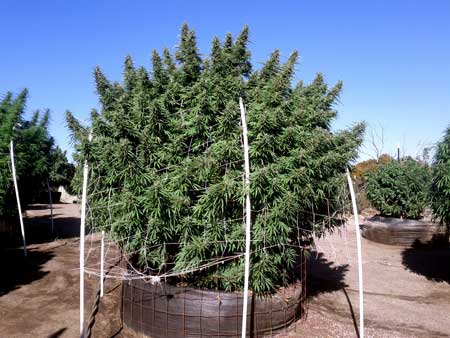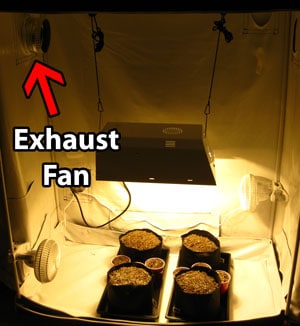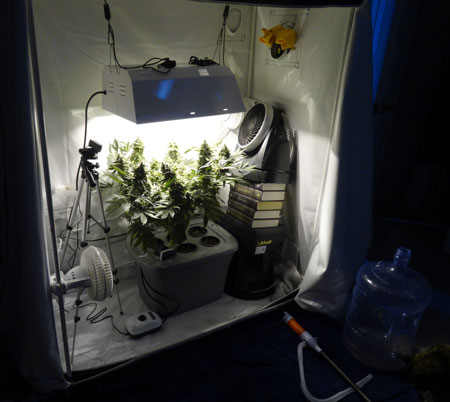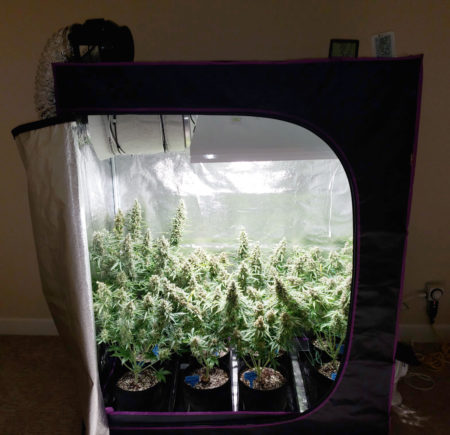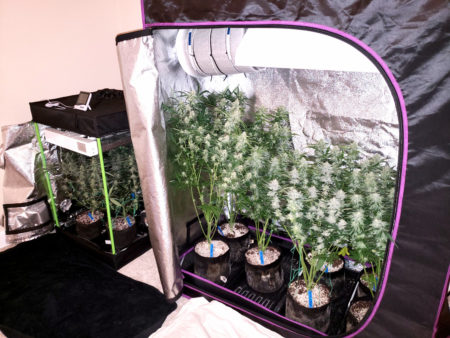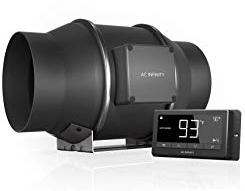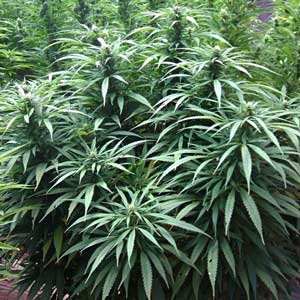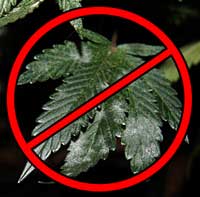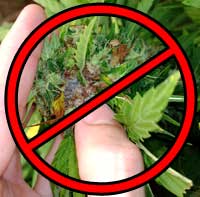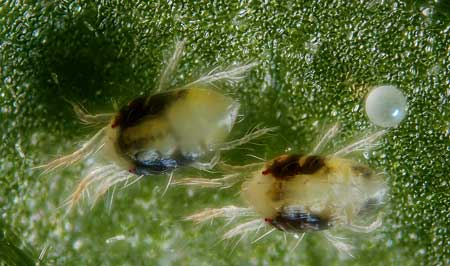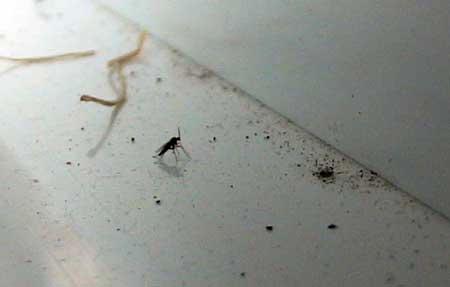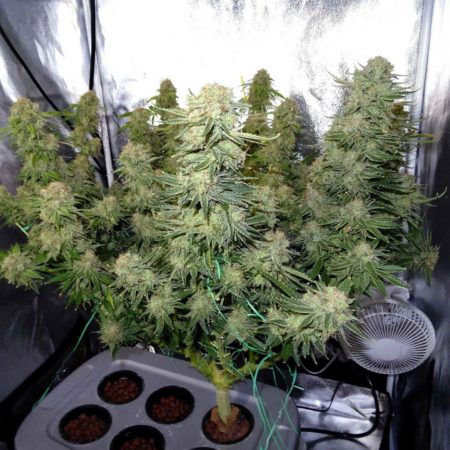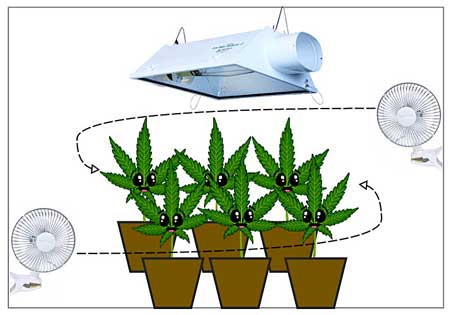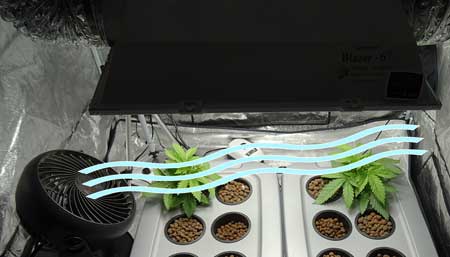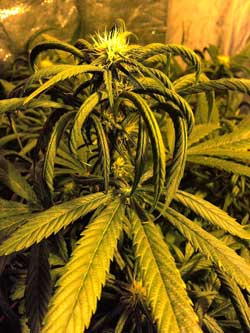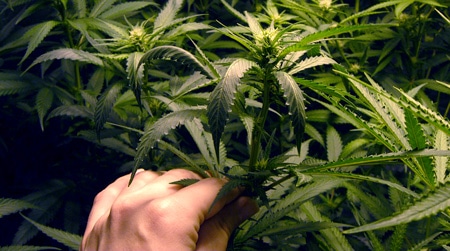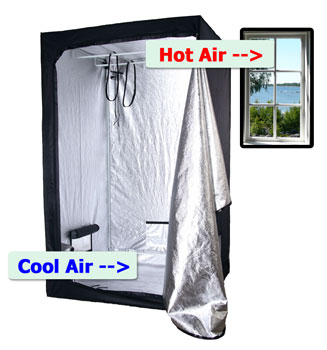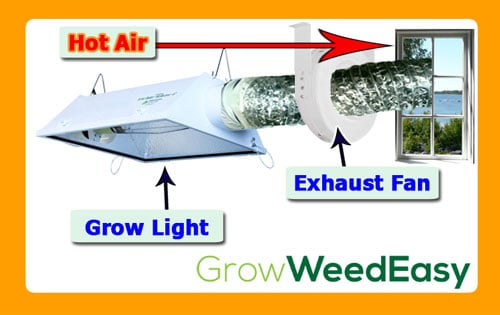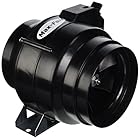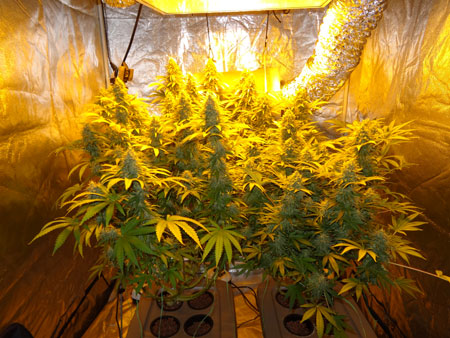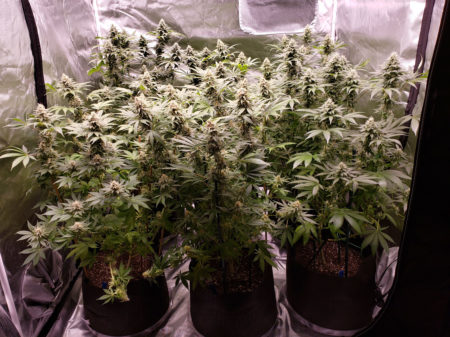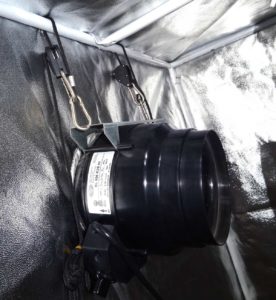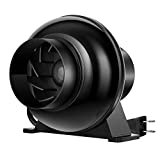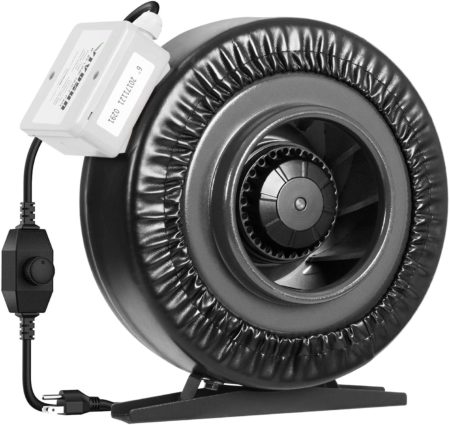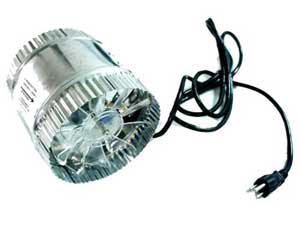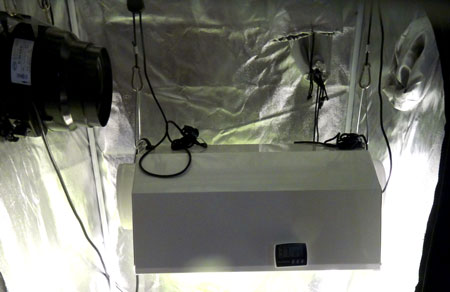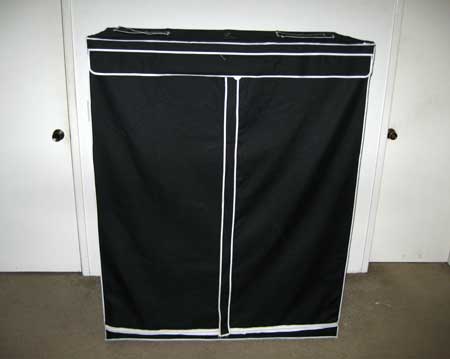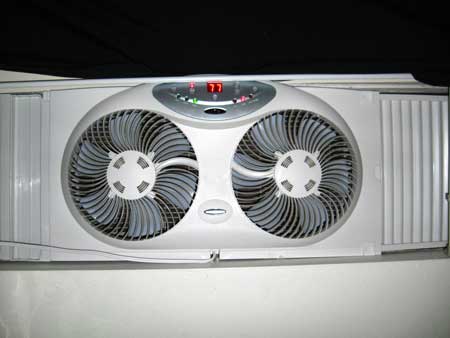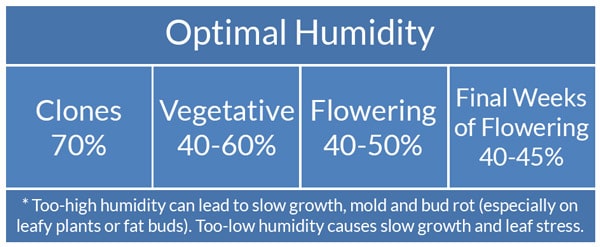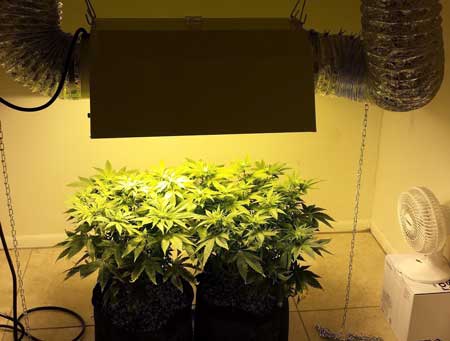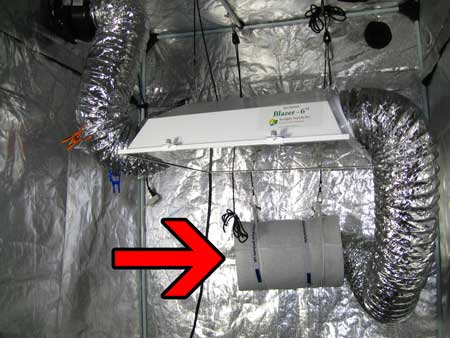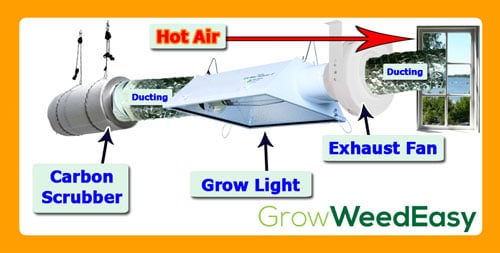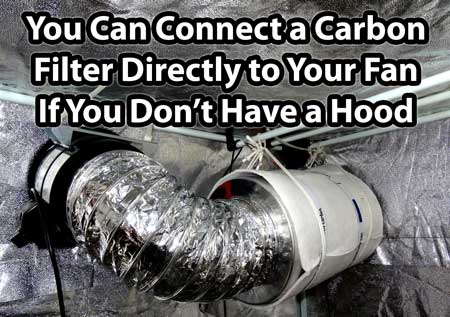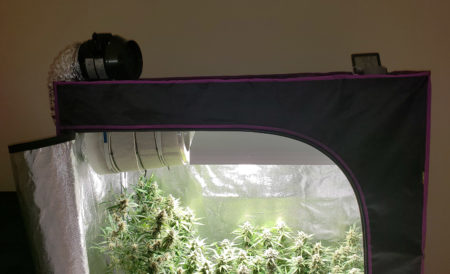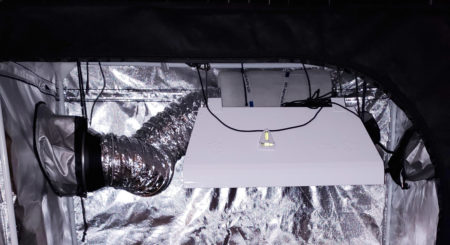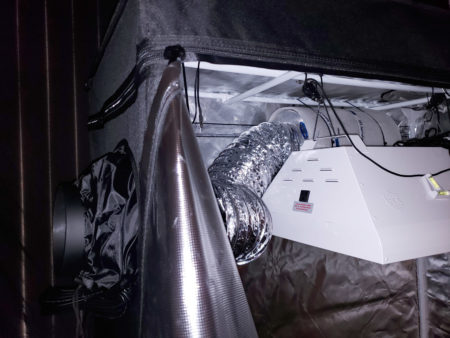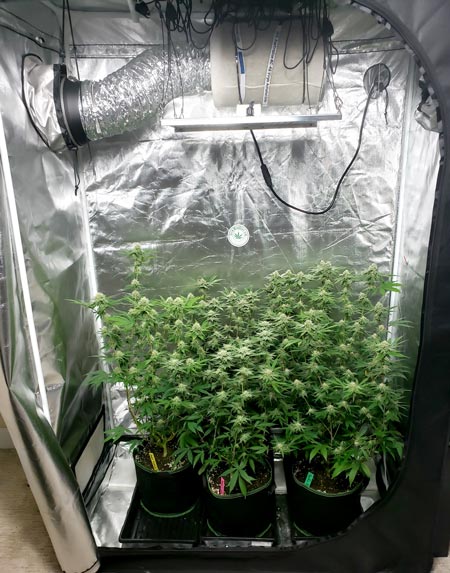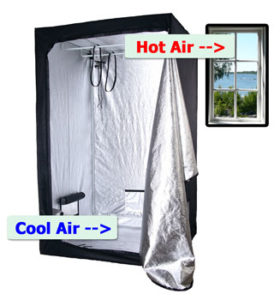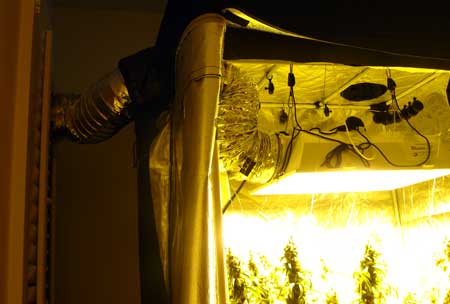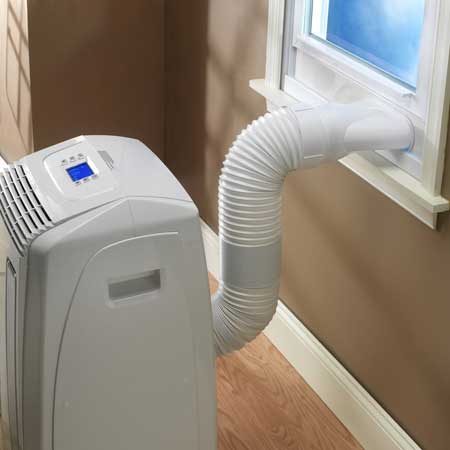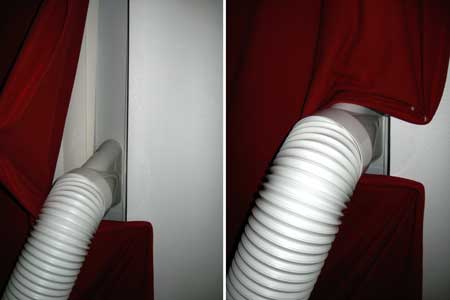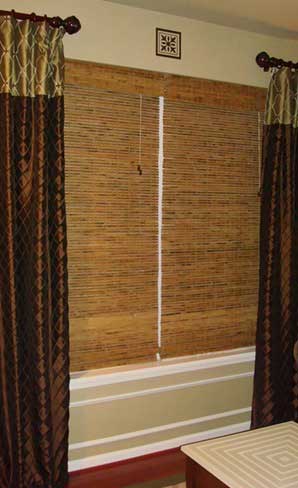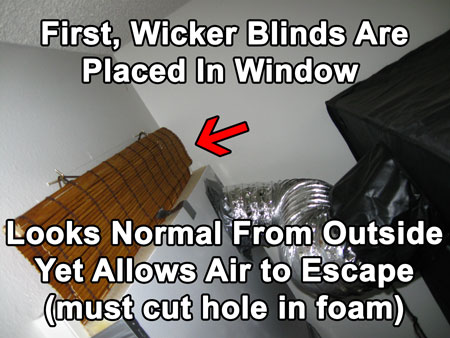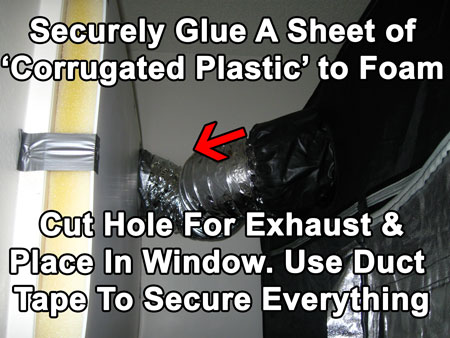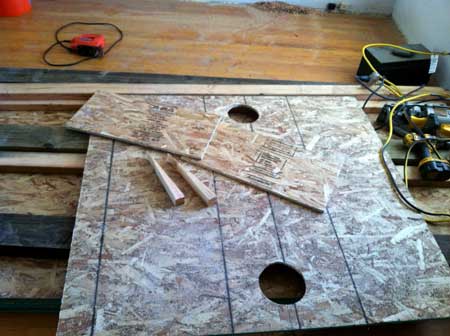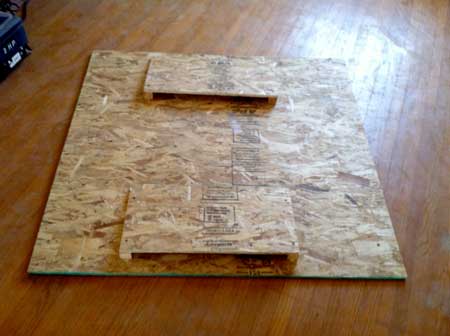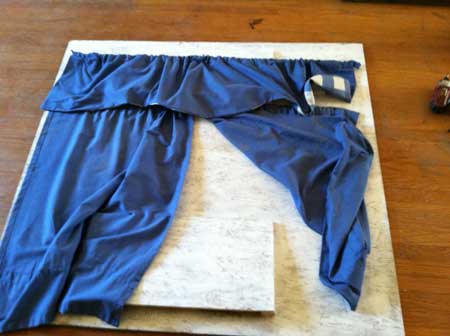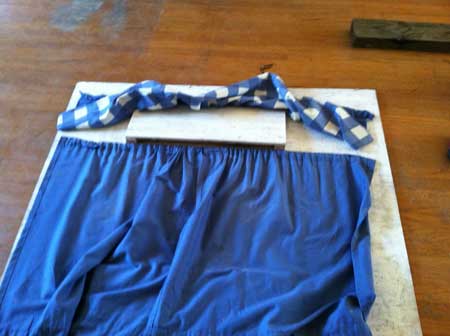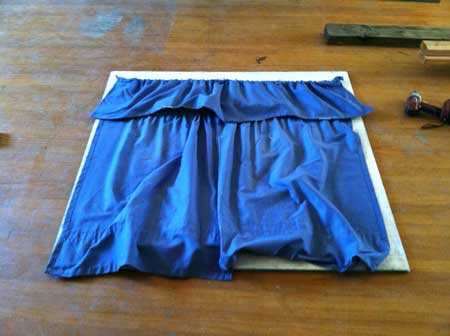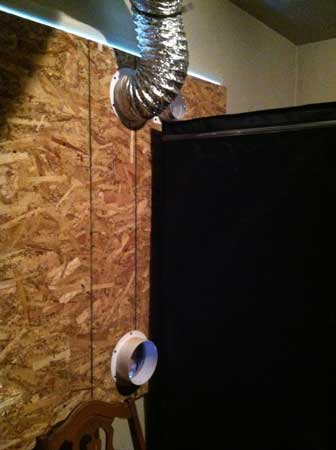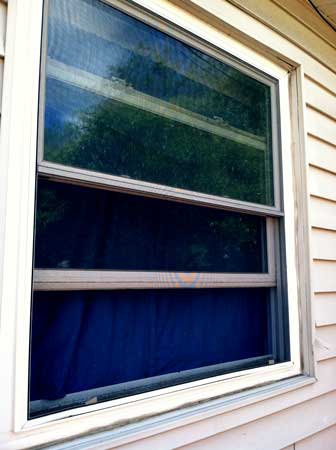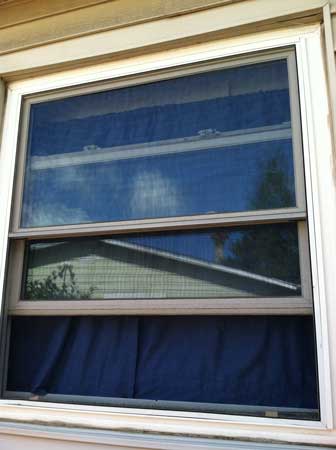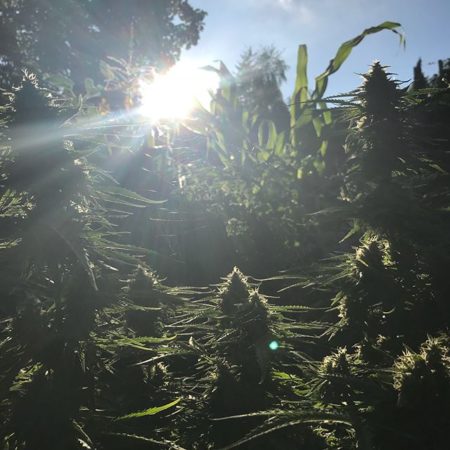by Nebula Haze
Table of Contents
What Are the Benefits of Great Air Circulation?
Fans: Everything You Need to Know
Temperature & Humidity Cheat Sheet
Deep Dive into Airflow & Exhaust Systems (transpiration, CO2 injection, suction, seals, and negative air pressure)
How to Set Up a Stealthy Exhaust System
How to Make a Hidden Window Exhaust (Examples)
Cannabis plants love a nice breeze and fresh air. When growing cannabis indoors, you have the ability to control the air circulation and use your exhaust to create the perfect indoor environment for your garden that mimics the best parts of nature.
A good growing environment copies the best parts of nature. This tutorial will show you how to create happy cannabis plants with the perfect environment
This air circulation and exhaust tutorial teaches you how to recreate an environment that makes cannabis thrive, and as a bonus it’ll prevent some types of bugs and mold. By venting out the hot air from your grow lights and pulling in fresh air, you increase your cannabis plant’s speed of growth and yields. Good ventilation pays for itself.
Here are some important points about great air circulation…
Plants Love It
- Faster Growth, Bigger Yields – Plants in the right environment grow faster and produce more buds
- Temperature & Humidity Control – An exhaust system helps control the temperature and humidity levels in the grow area by venting out hot and humid air, while replacing it with fresh air. Fans within the grow area circulate the air to prevent hot or humid patches.
- Prevent Mold & Pests – Many molds and pests like stagnant air, high humidity, and heat. Fresh, cool air blowing over and under your plants will reduce the chance they attack your plants.
- Stronger Stems – A breezy environment strengthens stems so they’re less likely to droop and fall when buds get heavy.
During my first indoor cannabis grow, I didn’t pay much attention to air circulation or creating an exhaust. I had a fan blowing directly on my plants and thought I was good to go.
I found out that growing weed plants without any way to exhaust heat caused the grow area to become too hot and humid, even with small grow lights. This led to several issues, including root problems, white powdery mildew, and heat burn. It could have been much worse because these same conditions can also lead to bud rot, fungus gnats, spider mites, and other unpleasant guests in the grow room.
This grow tent was too hot for optimal growth. I added a cheap ducting fan to vent hot air out and the temperature came down several degrees. A huge improvement.
But there was still a major hot spot directly under the grow light. I added a lot of small fans in this grow space, which helped.
But as soon as I upgraded to a stronger exhaust fan, the inside of the tent turned into a wind tunnel (in fact I had to turn the fan down). I was able to get rid of the small fans and plants still got more than enough fresh air. Bonus: Connect a strong exhaust fan to a carbon filter and completely erase smells before the air gets vented out. With this setup, you can’t smell the plants even in the same room.
Once I started exhausting out air from my grow area, cannabis plants grew faster, and certain problems like persistent droopiness and inexplicable nutrient deficiencies disappeared. It made me realize how many indoor cannabis growers may be unintentionally hurting their plants and yields by missing a few key points about air circulation and creating an exhaust to vent out heat.
Tips for the Best Environment
- Blow Hot Air Out – When it comes to cooling, typically it’s far more effective to blow hot air out of the tent than to try to blow cool air in. Just like how a computer fan is always pointed out.
- Exhaust Fan is Most Important – Small fans in the grow area move air around, but can’t reduce the overall temperature or humidity. On the other hand, a good exhaust fan not only keeps the air moving, but vents hot air out and draws fresh air in. That means if you can only afford one type of fan, it’s better to get a good exhaust fan. Venting and air movement are both important, and a good exhaust fan can do both.
- Use Powerful Fans with Big Plants or Hot Grow Lights – Each leaf is constantly adding water vapor to the air and raising the humidity. If your grow space is full of plants, you need a strong breeze to move the humid air. Along the same line, the more heat produced by your grow lights, the more powerful the fans need to be to move all the heat.
- Erase Smells with a Carbon Filter – If you connect your exhaust fan to a carbon filter, the smells get filtered out of the air before they leave the grow space. This is the most common setup to keep your cannabis plants from stinking up the place.
- Exhaust Systems Can Be Cheap & Stealthy – There are cheap and stealthy ways to create a great ventilation system without a lot of time, money, or effort. You have more options than drilling holes or ducting, and many window exhaust options are undetectable from the outside. Learn how to make a stealthy exhaust!
A grow tent is an inexpensive sealed grow space with built-in holes to vent heat. With a strong exhaust fan pointing out, you don’t need any other fans to get excellent air circulation. This gives you more room in the grow space for your plants.
Looking for a quiet exhaust fan?
If noise is a concern, the AC Infinity Cloudline series fans are a great choice. They’re essentially silent on lower settings, and still pretty quiet at full power compared to traditional exhaust fans.
Make sure to get the right size. AC Infinity fans are quiet but also less powerful than regular exhaust fans like the CanMax. If in doubt, size up.
The AC Infinity Cloudline Series is the quietest exhaust fans we’ve used. In my experience…
- the 4″ version can handle up to a 2’x2’x5′ grow tent and 200W of light*
- the 6″ version can handle up to a 2’x4’x6′ grow tent and 400W of light*
- the 8″ version can handle up to a 4’x4’x7′ grow tent and 600W of light*
*when I used smaller sizes for these setups, the fans couldn’t keep tents cool enough when attached to a carbon filter.
Air Circulation
Air circulation (the way air moves around in your grow space) is an important ingredient in creating a perfect growing environment for your cannabis. Indoor growers strive to create a better-than-nature environment for their plants. The way that air moves has a surprisingly big effect on how your plants will grow.
In nature, cannabis plants thrive in a gentle breeze
Why is Air Circulation Important?
Indoor cannabis plants are normally grown in a relatively sealed environment such as a closet, tent, or room dedicated to growing. The lack of wind indoors can cause some problems compared to growing outside. Outside, in ideal conditions, there’s a breeze flowing through plants, giving them fresh air and strengthening stems. Photosynthesis requires CO2, and a steady supply of fresh air helps cannabis grow faster. Air movement protects plants from certain pests and molds.
Benefits of good air circulation and an exhaust system include…
Protection against mold, bud rot, and white powdery mildew
Some protection from pests like fungus gnats and spider mites
Stems get stronger due to bending & swaying (like in nature)
- Better heat & humidity control for faster growth and bigger yields
Reduce Chance of Mold, Bud Rot & White Powdery Mildew
As air blows over the leaves, it carries away moisture released during transpiration. This allows your plants to drink more water (and pull in more nutrients) at the roots. This regular removal of moisture on the leaves also greatly lowers your chance of running into mold, bud rot, or white powdery mildew.
Protects Cannabis Against Spider Mites & Fungus Gnats
Air flowing over the plants and soil fights against nasty garden pests like spider mites and fungus gnats by making it hard to fly and drying out the top layer of soil.
Spider mites and fungus gnats both love stagnant air and have trouble living in a strong breeze. A breeze also creates a lot of air circulation over the plant containers, which keeps the top layer of soil relatively dry. Dry topsoil makes it hard for pests like fungus gnats to breed (moist topsoil creates a perfect breeding ground for molds & fungus gnats).
Whether growing inside or outside, growers with a nice breeze blowing over their plants and soil tend to get less pests.
Temperature & Humidity Control
Great air circulation combined with an exhaust system helps disperse water vapor and heat evenly throughout the grow space. Small oscillating fans blowing above and below the plant canopy helps equalize the air so there are no hot or humid spots.
An exhaust system ensures that all the air in the grow space is replaced regularly, so plants stay cool, get a fresh supply of CO2, and live in the right humidity. It’s important for plants to be exposed to fresh, moving air for the best growth rates. Learn more about temperature and humidity.
Strengthens Stems
A nice breeze strengthens stems by allowing them to bend and sway like in nature. This builds up the strength of stems over time, which comes in handy when plants start to get big and heavy from buds.
Placing Fans In The Grow Area
Many indoor cannabis growers use small fans to blow air around within the grow area. This creates a nice, breezy environment that cannabis plants love. If your temperature and humidity is under control with your grow lights on, small fans are all you need.
Placing Fans
Ideally, you’d like a nice breeze surrounding the main canopy, which means you want air blowing above and under the plants.
Don’t point a strong fan directly at plants because too much wind can damage the leaves and stems. Sometimes you get the best air movement by pointing fans directly at the wall. This disperses the breeze so it’s not too strong.
After placing fans, gaze around the grow area to make sure that all parts are getting a slight breeze. If you feel stagnant air or a lack or breeze, you may want to adjust your fans.
Small oscillating fans provide a breeze to a relatively wide area without blowing on any one part too long.
Be Careful! Too Much Wind Causes Clawed Leaves
When there’s too much breeze, the affected leaves will start getting “wind-burned.”
Wind-burned leaves are often curved under and form “claws.” They can look like they’re droopy from overwatering, underwatering, or possibly a nitrogen toxicity, but you know you’ve got wind-burn when the leaves in front of the fan are making claws while leaves further away from the fan look fine.
Just for reference, here’s what too much wind/fan looks like!
Choosing the Right Exhaust Fan & Exhaust System Tutorial
Even when you’re not worried about heat, it’s still important to regularly replace all the air in the grow area, which means you need a way to vent out old air. An exhaust system uses fans and often ducting to move hot and humid air out of the grow space.
Designing an efficient exhaust system will be much simpler if you take the time to understand airflow in a room – the whole idea of setting up an exhaust system is to create negative airflow in the grow space or grow tent so that any hot air is regularly replaced with new, fresh cool air.
All the air in the tent should be replaced by new air every 1-3 minutes for the best results. I recommend aiming to replace the air every one minute unless you live in a cool place. You can calculate the strength of the exhaust fan you need based on the dimensions of your grow space.
In order to move air out of the tent and vent it outside, you need to use at least one strong fan as part of your exhaust system.
How to Calculate Exhaust Fan Strength
In the US, most exhaust fans have a “CFM” rating. This means “cubic feet per minute” and is talking about how much air the fan can move each minute. It’s important to get a fan with the correct CFM rating for your size space.
In addition to CFM, there are 3 sizes that exhaust fans come in as far as diameter (how wide the fan is). They usually come in 4”, 6” or 8”. Generally it’s recommended to get a 6” for most setups since most air-cooled hoods and ducting have a 6” opening. You can also use converters if you need to convert a 6” hold to a 4” fan. 8” fans are usually used for more high-powered grows.
Here’s a short equation to help you roughly determine what CFM rating you need for your fan in your space.
How to calculate CFM needed
Determine the cubic area of your space by multiplying Length x Width x Height. You want to exhaust this amount of air at least once a minute.
Exhaust Efficiency – Every exhaust system has some level of inefficiency, which will lower the amount of air being moved by the fan. This step tells you how much extra air-moving power is needed to compensate. In an efficient exhaust system, air goes in a short, straight line after passing through the fan. An inefficient path is when air has to go a long way after leaving the fan, or if the air has to go around turns instead of being in a straight line, or if it has to go through a carbon filter. This step will help make sure your fan is moving enough air to properly ventilate your space.
• Efficient path / No Carbon Filter- multiply previous number by 3
• Inefficient path / Carbon Filter- multiply previous number by 5Pick your fan. Inline exhaust fans are measured by CFM (cubic feet/minute), so you need a fan that has a CFM higher than the number you figured out in the last step. However, not all CFMs are equal. If something is listed as a “Booster” fan, it typically is no nearly as strong as an inline exhaust fan with a similar CFM.
Fan CFM Rating Table
(here are some examples of possible setups using the equation above to figure out CFM)
| GROW SPACE SIZE | Average Light WATTAGE | Minimum CFM* |
|---|---|---|
| 2’ x 2’ x 5’ | 120W | 60-100 CFM |
| 2’ x 4’ x 5’ | 250W | 120-200 CFM |
| 3’ x 3’ x 6’ | 400W | 162 – 270 CFM |
| 3.5’ x 3.5’ x 6.5’ | 600W | 238 – 398 CFM |
| 4′ x 4′ x 7′ | 1,000W | 336 – 560 CFM |
* Of course fans don’t come in these sizes, so round to the closest fan size available.
You’ll generally need a higher CFM rating if your grow space tends to get hot or humid, and it’s usually better to get an exhaust fan that is too big than one that is too little since you can turn it down if necessary.
For example, I used the following exhaust fan in my 2’x4’x5′ tent with a 250W HPS. It’s stronger than I needed by far, and I usually have it set to Speed 1 or 2, but it’s better to have too much airflow than not enough. There have definitely been times, such as during heat waves, where I’ve turned it up all the way to control the temperature.
Some fans are very strong, like this Can Max 6-inch inline fan with 334 CFM. This is the fan I use and I’m very pleased with it even in smaller tents like the 2’x4’x5′. If you get an extra strong fan with a variable speed controller, it means that you can turn the power of the fan up or down at will. This can come in handy if you have a heat wave. For an extra investment, you get a lot more power. This fan has a 201 CFM “low” setting, which uses about ~60W watts, a “medium” 264 CFM setting, and a “high” 334 CFM setting which uses about 75W of electricity.
Avoid “Booster” fans like the one below. I’ve used them before because they are just so cheap (often only around $25 brand new), and the truth is they are better than nothing. BUT, they use a surprising amount of electricity considering how little airflow you get, and you can’t really trust the strength of their CFM ratings. The following 6″ Booster fan uses 37W of electricity for “240 CFM” and yet the airflow is extremely weak compared to the Can Max fan above on its “201 CFM” low setting.
When do you need a booster fan? Most indoor growers with hobbyist-size setups won’t ever need to do this, but if the exhausted air has to travel a long way after going through your fan before it’s vented outside (for example the air has to go through several feet of curved ducting after passing through the fan), a single exhaust fan might not be enough. You may need booster fans along the way to keep the air moving especially around long stretches or tight turns.
Bigger Grow Lights Need Bigger Fans
HPS grow lights are known for producing a lot of heat. This 600W HPS grow light needed a powerful exhaust fan but I was able to keep it cool and breezy with a Can Max 6-inch 334 CFM inline fan.
I quickly need to dispel the common myth that LEDs don’t produce any heat. Although LEDs are known to run cool, even ultra-efficient LEDs produce significant heat at higher wattages. The electricity use of a grow light hints at the amount of heat it will produce. If one grow light draws 300W from the wall, it will generally produce significantly more heat than a grow light that pulls 200W from the wall, regardless of the type of grow light. In other words, power draw from the wall is a rough indicator of the heat to expect from a grow light whether it’s CFLs, LEDs, HPS, or CMH/LECs.
These plants grew under 600W of LEDs (the same electricity as the 600W HPS above) and grown in the same grow tent. Although they produce less heat than the HPS, they still make the tent hot enough that I used the same size exhaust fan. The heat reduction wasn’t enough to allow me to go down a fan size.
If you’re concerned about heat, pay attention to the real power draw when shopping for grow lights.
NOTE: When using a powerful exhaust fan, hang the fan from the top bars inside of your tent to help keep it quiet. If you set a fan on top of your grow tent it will make it sound a lot louder. Learn more about setting up a grow tent for cannabis.
Hang your exhaust fan from inside the tent to help reduce noise
The AC Infinity Cloudline Series are the quietest exhaust fans we’ve used so far.
In my experience…
- the 4″ version can handle up to a 2’x2’x5′ grow tent and 200W of light*
- the 6″ version can handle up to a 2’x4’x6′ grow tent and 400W of light*
- the 8″ version can handle up to a 4’x4’x7′ grow tent and 600W of light*
*when I used smaller sizes for these setups, the fans couldn’t keep tents cool enough when attached to a carbon filter.
When in doubt, it’s usually better to get a bigger exhaust fan than you need, as long as you can adjust the fan speed. You can always turn down the fan if it’s moving too much air. You could also use a speed controller or put the fan on a timer if the exhaust fan is moving air out of your space too fast. There are often times during a grow where it’s helpful to be able to move more air, so size up if you can when it comes to exhaust fans.
In addition to the exhaust fans above, these are two more examples of suitable choices for exhaust fans. These are loud but very effective:
- 4-Inch Exhaust Fan – 195 CFM <– You need a separate speed controller to change the speed of this fan since one is not already built-in.
- 6-Inch Exhaust Fan – 440 CFM <– Not as high quality as my trusty Can Max 6-inch 334 CFM fan listed above (which I prefer), but it’s quite a bit cheaper
This 4-inch exhaust fan is good for small tents with up to ~200W grow light (true power draw)
This 6-inch exhaust fan is good for 4’x4’x7′ tents with up to ~600W grow light (true power draw)
A cheap ducting fan may have a high CFM rating (this 6″ duct fan says it moves 240 CFM) but they don’t have enough power to move a lot of air. If a fan looks like this, it’s going to be much weaker than you’d think from the CFM rating.
Don’t get this type of exhaust fan if you can afford something better!
Passive Intake
A passive intake means that you have a hole for cool air to get in, but aren’t using an intake fan to help bring in extra fresh air.
With every passive intake, make sure your intake holes are in total 3-4 times bigger than your exhaust hole to achieve proper suction and prevent your fan from working too hard blowing out air it can’t replace. You can also help bring air in by having more than one passive intake hole. In other words, the holes/spaces for new air to come in (vents, intake fans, doors, windows) should be bigger than the hole/space where the air is being pulled out of the tent by your exhaust fan.
Active Intake
An active intake simply means that you’re using an extra fan to intake more air. So in addition to your exhaust fan, you also have a fan at your intake hole blowing air in. With an active intake, it’s not as important to have a huge intake hole, since the intake fan will help replace the air. An active intake is often a good idea if your intake hole is the same size as your exhaust hole, or if your exhaust fan is struggling to move all the air.
Keep your grow tent closed if using an exhaust fan. Opening the tent reduces suction and actually prevents the fan from being able to pull the hot air out.
Easy “Exhaust System” Example (No Ducting)
A lot of people want to grow a lot of cannabis but are not willing to install ducting or make a real exhaust system. I understand why – most exhaust systems do not look “stealthy.” Ducting looks incredibly out of place in the home environment. But here’s how to control heat for relatively smaller grows.
Main Idea: Vent hot air directly into the room, then use a window fan to blow it outside
What You Need
Relatively small grow light (under 300W)
Access to a window (for example a grow tent in a bedroom)
Exhaust fan – An exhaust fan that matches your grow light and grow space (examples above)
Window Fan – I use the Bionaire BW2300 Twin Window Fan because it moves a lot of air and actually fits my huge windows. Another option is the Holmes Dual 8″ Blade Twin Window Fan. Any strong fan that fits your window will work.
A small grow tent provides a great growing environment for smaller grow lights but doesn’t look too suspicious. A few people have seen this grow tent and didn’t mention it.
Here’s what you do (it’s easy)
Set up your grow tent with grow light inside
Install your exhaust fan at the top of your tent, blowing air out. Make sure there’s an intake hole for new air to get in. The intake hole should ideally be bigger than your exhaust, and should be located on the bottom of the tent on the opposite side of your exhaust fan. This isn’t always possible, but ensures the best results. Most grow tents already have a suitable intake hole, so this is another reason I like grow tents – less work needed on your part to make a good environment for your plants
Install window fan blowing air out in the same room as the tent. This window fan will only be effective if the room has an intake hole, just like your grow space. For example, you could open the door to a cooler room or hallway. If it’s cool outside you could open another window in the same room, though be aware if bugs can get in. Basically, there just needs to be a source of cool fresh air to get sucked in when the window fan blows hot air out. In some cases with certain window and room setups, for example if you don’t have a good source of cool fresh air indoors, you might find it more effective to have the window fan pointing in. Experiment if you’re having trouble. Sometimes small changes make a big difference.
This may not be a permanent solution, but it gets the air moving through the tent and keeps the air moving out of the house. You’re basically building an exhaust system without the ducting. It’s not as efficient as using ducting, but for a lot of growers with just a few plants, it’s all that’s needed to control temps in the grow room and tent. As long as it’s cooler outside than inside, the window fan will cool down the room.
This window fan is a “Bionaire BW2300 Twin Window Fan” but any strong window fan will work. They’re available in hardware stores, Best Buy, Walmart, and on Amazon.com. They have extenders so they’ll fit any window snugly, without gaps on either side.
What about smells? All the normal techniques used to control smells will work for this system. The best option to control odors is to create an exhaust system that gives your tent good suction/negative air pressure. Then have your air pass through a good carbon filter just before going through the fan and leaving the tent. With a good strong exhaust system and a quality carbon filter, this will prevent smells in the bedroom or outside except when you actually open the tent. Learn more about carbon filters and controlling smells
Now for growers with bigger grow lights, such as 400W and greater, usually a more robust exhaust system is needed to keep lights cool if the grow space isn’t naturally cool.
Temperature & Humidity Control Cheat Sheet
1.) What is the temperature and humidity where the plants are? If the plants are experiencing temperatures above 85°F (30°C) or humidity above 60%…
- You need to vent air out of the grow space and replace with fresh cool air (full tutorial below)
- Remember that the inside of the space near the grow light is always going to be a few degrees warmer than the room. No amount of fans can make the grow space cooler than the temperature of the room itself
- That means if the room itself is getting warm, you need to find a way to cool the room before you can achieve a cooler grow space
2.) What is the overall temperature and humidity of the grow room? If the grow room feels hot or humid, you can either…
- Vent air out and replace with cool fresh air (for example venting out a window), or
- Use equipment that will actually change the overall temperature/humidity
- Air Conditioner (AC) – Lowers Temperature, Lowers Humidity
- Swamp cooler (Evaporative Cooler) – Lowers Temperature, Raises Humidity
- Dehumidifier or Heater – Raises Temperature, Lowers humidity
- Humidifier – Raises Temperature, Raises Humidity
Transpiration – Leaves Adds Humidity to the Air
When it comes to air circulation and exhaust, humidity is something you need to pay attention to in addition to temperature.
Leaves are constantly giving off water vapor into the air; in fact, that’s how the plants bring up water from the ground. As the water transpires through the leaves, it pulls up more water from the roots like a straw.
This is known as “transpiration.” Transpiration is a process where leaves give off water vapor. That means that the humidity will always be rising in your grow area unless you find a way to vent that humid air out (or use a dehumidifier to remove the extra moisture).
Transpiration happens via the stomata, little pores that are located on the leaves of the plant. Stomata let oxygen and carbon dioxide in for photosynthesis, while letting water vapor out. A closeup of a single stoma from a tomato plant is pictured to the right.
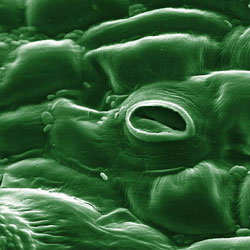
Stomata get bigger when there’s bright light and high humidity since leaves need air for photosynthesis and the plant isn’t “worried” about losing too much water vapor in humid conditions. Because stomata must be open as part of the photosynthesis process, it also means that photosynthesis stops when the plant gets too dry.
Stomata must be open for transpiration to happen, so when the stomata are closed the plant has a hard time taking up water and nutrients through the roots. When there’s too much water in the plant, sometimes the stomata can’t let enough water vapor out, which is part of what causes the symptoms of being overwatered.
Plant leaves can’t get access to CO2 and constantly lose water when the stomata are open, so the plant can’t take in CO2 without also letting water vapor out.
So what you need to remember is that leaves are constantly adding humidity to the air. It’s important to remove this humidity from the grow area if the humidity climbs too high, or it can set up conditions that cause mold, bud rot and powdery mildew.
To Lower Humidity – Vent out humid air via an exhaust system – the humidity will drop (as long as the new air is less humid)
To Raise Humidity – Plants can usually adjust to low humidity but if it’s really dry you can turn down the exhaust fan to help raise humidity. Typically, once plants get bigger they’ll be giving off enough water vapor that you don’t need to worry about too-low humidity.
Large plants raise humidity fast – Small plants don’t put off a lot of water vapor, but larger plants have a lot of leaves releasing water vapor into the air, causing the humidity to rise quickly unless the humid air is being vented out. Remember that most of the water you’re giving to your plants is being released into the air of your grow space, so you need to find a way to get that humidity out, especially in the flowering stage when high humidity can lead to bud rot.
Dehumidifiers and humidifiers can help control the humidity when an exhaust system isn’t enough
Aim to keep humidity at these levels…
How to control humidity in the grow room: https://www.growweedeasy.com/humidity
CO2 Injection Requires a Sealed Grow Space
In order to use CO2, it’s important to completely seal up the grow room. CO2 is only effective at very high amounts, and you need a sealed grow space to get the concentrations up high enough to benefit plants.
More importantly, CO2 is dangerous to humans at the levels that are recommended for plants. Sealing the grow area is incredibly important to prevent CO2 from leaking into the home.
Learn more about how to use CO2 here: https://www.growweedeasy.com/co2
Suction, Seals & Negative Air Pressure
As far as seals, it’s important that you seal the entire exhaust system after air passes through the exhaust fan. This helps keep the exhaust system efficient. If you’re using a carbon filter, this also makes sure that all air passes over your filter before being vented out of the grow space. A sealed exhaust system along with a carbon filter will prevent smells from escaping outside.
Negative air pressure is something you can create to keep smells from escaping the grow room, so you don’t have smells leaking into the rest of your home..
In order to create negative air pressure, you seal the grow space except for the intake and exhaust holes, which creates suction when you turn on the exhaust fan.
In other words, suction is what you create with seals and negative air pressure.
When your grow tent is bending in from the exhaust fan, it means you’ve got good suction going in there and have created negative airflow. You can also check by burning incense near the intake hole; if the smoke is moving straight to the intake hole you know that you’ve got good negative air pressure bringing fresh air inside.
When you’re in an open grow space without suction like a room or closet, there are not as many universal principles. You may have to experiment with a few different exhaust system setups until you find the best way to manage heat.
Controlling Smells With Your Exhaust
The best way to control smells in the grow room is to use a carbon filter. It is the only method of controlling smells that I recommend for everyone, because it is the most effective and can actually completely scrub smells from the air so they never escape the grow area, either inside or outside the home.
But when using a carbon filter, the way you set up your exhaust is important. Most importantly, the air from the grow area should pass through the filter and be brought straight outside. It needs to completely air-tight after air passes over the filter.
You can set things up a few different ways:
- Carbon Filter (inside) > Air-Cooled Grow Light > Exhaust Fan
- Carbon Filter (inside) > Exhaust Fan
- Exhaust Fan (inside tent) > Carbon Filter (outside tent)
Important: The Carbon filter needs to be either at the beginning or the end of the line to be effective at reducing smells. Here are examples of effective carbon filter setups.
Example of carbon filter with air-cooled hood (old fashioned). Note: This worked but the system would be much more efficient with shorter ducting (the longer the air has to travel, the less efficient the system)
Air-cooled hoods are much less common these days. In that case, connect the carbon filter directly to the fan.
Here are some examples:
Carbon filter inside, Fan outside
Carbon filter inside behind light, fan in port
Same setup from a different view. This allows you to move even a big hood almost to the top of the grow space.
An example with an LED grow light
If you’re using a carbon scrubber, it’s important that all air from the grow room goes through the carbon filter before it gets outside. If there are air leaks at any point in the system, smells will escape and the system won’t efficiently cool. By ensuring an airtight exhaust with good suction in the tent, you’ll prevent smells from making it outside or inside the house.
Learn more about controlling smells in the grow room: https://www.growweedeasy.com/how-to-control-smell-when-growing
How to Create a Stealthy Exhaust System
The carbon filter (to scrub smells) isn’t needed in all setups, but the principle for all exhaust systems is the same: Intake cool air and vent out hot air.
What you need:
- Grow Tent (or any sealed grow space with a way to hold up lights and carbon filter)
- Rope Ratchets to hang grow light and carbon filter (usually comes with your grow light, but it’s nice to have extras)
- Grow Light – compare cannabis grow lights
- Exhaust Fan – discover which fan is right for your space
- 6″ Ducting with Ducting Clamps (if you plan on using ducting)
- Carbon Filter (if you want to prevent smells from leaking out of your grow tent) – learn about carbon filters
- A way to hide exhaust vent from outside (if needed, explained below)
Step 1: Set up your grow tent
Step 2: Install both fan and carbon filter(if you plan to use one). These items are often tough to install after the grow light, so get these parts in place before you go to the next step
Step 3: Install your grow lights in the tent with rope ratchets. Don’t plug in anything until you’re about to start growing.
Step 4: Inside the grow tent, connect everything with ducting if desired.
Step 5: Outside the grow tent, install ducting to bring air from fan to exit outside. Use ducting to connect the exit port on your fan to wherever you’re going to exhaust hot air. Try to create a short, straight path that’s as air-tight as possible until air is safely outside.
Step 6: Ensure an intake hole is open so new fresh air can enter the tent. Also make sure that there’s a window or door open in the grow room so fresh air can come inside to replace the hot air being vented out.
The following exhaust system ideas take heat from the grow light and vent it directly out a window with ducting
Tip: Make sure there is no extra slack in the ducting if possible. you will need extra ducting to be able to adjust your lights, but use something like binder clips or chip clips to bunch together extra ducting.
Keeping a straight path that air has to go through will help make the whole exhaust system more efficient.
If things are getting too cold in the grow area (for example in winter months), you can exhaust the heat back into the grow room to help warm things up, or you could turn down the overall air being moved by your fan by putting it on a timer or using a fan speed controller. Some growers even exhaust the heat into the house in the winter for free heating.
The next big problem is that a lot of people want to be able to exhaust their hot air without anyone being able to tell from the outside.
Here are some ideas for setting up a stealthy exhaust in a window that looks completely normal from the outside while allowing air to pass through easily.
Fake window AC unit – Use window kit to disguise the exhaust from a grow area.
This method takes advantage of the fact that portable air conditioners come with a special window kit that fits into most windows. This looks completely normal from the outside.
A portable AC usually looks something like this. Notice the classy window fitting.
You can buy a replacement window kit and install it in your window. It has a hole to vent air outside, but looks like you just have an AC. While most ducting won’t fit it without extra help, you can use adhesive foam to help the ducting make an air-tight fit with the exit hole.
What You Need
- Window kit for a portable AC
- Adhesive foam, duct tape or hot glue to connect ducting to window kit
- A way to blackout the rest of your window (for example blackout curtains that don’t let light through but look like regular curtains)
Here’s an example of a window kit available on Amazon.com
This is what a fake portable AC vent looks like in your window from the inside
Having trouble finding a cheap & easy way to stealthily exhaust out hot air from your grow tent? I used a combination of the following items to create an awesome exhaust system for about $45 (just add your fan).
This method takes advantage of the fact that wicker blinds do not allow anyone to see in, but they do allow air to pass in and out.
Wicker blinds offer privacy but still allows air to pass through
What You Need.
- wicker blinds that fit your window
- foam about the size of your window (usually cheaper to buy in person at a hardware store like Lowes or Home Depot)
- corrugated plastic sheet about the same size as your window (also known as “Twinwall Plastic Sheet” or “fluted polypropylene sheet” or “plastic cardboard sheet”). This is often cheaper to buy in person since you can only buy packs of them online. This item can be replaced with another sturdy backing material like wood since you are using this to give structure to the foam, but corrugated plastic is simple to work with and can easily be cut with sharp scissors or a box cutter (no special tools needed).
- duct tape
- 6″ ducting (should match the width of your fan, but the most common exhaust fan size is 6″)
- super glue or hot glue (with any glue, it’s a good idea to read the directions even if you’re already familiar as they sometimes have helpful hints and tips for different types of surfaces)
- staple gun
*All these items can be found at a home improvement store, as they are common items for upgrading around the house
First, hang the wicker blinds in your window like normal. Air can escape through these blinds, but you can’t see through them to the other side. They are commonly used in bedrooms and other windows that lead into private areas.
I bought a huge sheet of foam and glued (super glue and hot glue for best results) it to a sheet of corrugated plastic. You can buy both these items for a few bucks at a home improvement store like Home Depot.
Next, use some ducting to trace a round, duct-sized hole on the foam/plastic. Note: Cut out the duct-sized hole in the foam/corrugated plastic near the top of where it will be mounted. Remember, heat rises, so having the air exit near the top of the window is most efficient.
Run the ducting through the hole you cut, and right up to the wicker blinds. The ducting should be butted up against the wicker blinds so that heat escapes directly outside (since it will be able to pass through the blinds easily). Use duct tape to hold the foam/plastic in place, then use more duct tape to hold the ducting in place. At the end, after everything is placed and you’re happy with how everything looks, you will use a staple gun to staple all your duct tape in place, but don’t worry about that yet.
I also used duct tape to secure the foam to the window because it’s cheap, easy to use, and is very durable when combined with staples.
Normally you want to ensure ducting is as straight as possible, but in this case, make sure that the ducting bends a little during its path. The bends act as a “light trap” to prevent light from being visible behind the wicker blinds.
Use a staple gun to reinforce anywhere you use duct tape, including where the ducting goes through the hole you made in the foam.
I like using foam + corrugated plastic because it’s inexpensive and easy to cut the hole for the exhaust. Having the foam/plastic combo in the window increases the suction in the room so more hot air is vented out and blocks light (no light gets in or out). As an added bonus, the foam dramatically reduces the noise of the fan (so you can just barely hear it even when you’re standing right outside the window).
Sent in by a reader named Ray. Love this idea!
This grower needed an entry and exit hole in this window, which is why there are two holes cut out. The hole at the top is going to become the exhaust port to vent out hot air. The hole at the bottom will be how new fresh air enters the grow space.
With a small entry hole like this, the grower would need an intake fan to help move air into the grow space. If this were just a passive intake (no intake fan), then the intake hole should be about 4 times the size of the exit hole. This helps prevent the exhaust fan from working too hard, and will cool the area more efficiently.
This next picture shows the side that will become the front (outward-facing) part of the fake window. This setup allows air to pass in and out freely but blocks light from both sides.
After adding some fake curtains, this secret window exhaust is really starting to come together.
Here’s what that window looks like from the inside when it’s been hooked up. The heat exhaust is on top while the intake is on the bottom.
Completely undetectable from the outside. No one would ever give this window a second glance.
From the grower: “I prefer to use mini blinds, but these curtains were all I had at the time.”
Jump to…

